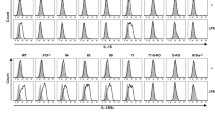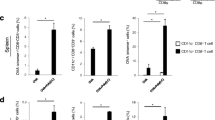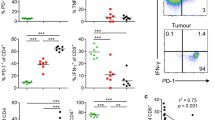Abstract
One of the factors influencing the efficacy of tumour cell vaccines is the site of immunization. We have shown previously that gene-modified vaccines delivered directly inside the spleen induced antigen cross-presentation by splenic antigen-presenting cells (not B cells). Here, we examined the interaction between splenic CD11c+ cells and antigen-specific CD4+ T cells. We used tumour cells expressing ovalbumin (OVA), a situation where CD4+ T-cell help is required for the generation of a cytotoxic T lymphocyte response. Using in vivo bioluminescence imaging of luciferase-expressing EL4-OVA cells, we could demonstrate that tumour cells were located exclusively inside the spleen following intrasplenic injection. We showed that after intrasplenic immunization with T/SA-OVA cells, splenic class I+ class II+ CD11c+ cells engulfed and presented in vivo the OVA class I-restricted peptide SIINFEKL. However, in vivo previously adoptively transferred 5,6-carboxy-succinimidyl-fluorescein-ester-labelled transgenic CD4+KJI-26+ cells specific for the class II OVA323–339 peptide underwent abortive proliferation in the spleen. These CD4+KJI-26+ cells were only transiently activated and produced IL-10 and IL-4 and not IFN-γ. It appears that splenic CD11c+ cells can downregulate splenic specific CD4+ T-cell response thereby leading to a decrease in antitumour systemic immunity.







Similar content being viewed by others
References
Blankenstein Th, Qin Z . The role of IFN-γ in tumour transplantation immunity and inhibition of chemical carcinogenesis. Curr Opin Immunol 2003; 15: 148–154.
Lollini PL, Forni G . Antitumour vaccines: is it possible to prevent a tumour? Cancer Immunol Immunother 2002; 51: 409–416.
Kündig TM, Bachmann MF, DiPaolo C, Simard JJL, Battegay M, Lother H et al. Fibroblasts as efficient antigen-presenting cells in lymphoid organs. Science 1995; 268: 1343–1347.
Shoenberger SP, Jonges LE, Mooijaart RJD, Hartgers F, Toes REM, Kast WM et al. Efficient direct priming of tumour-specific cytotoxic T lymphocyte in vivo by an engineered APC. Cancer Res 1998; 58: 3094–3100.
Cayeux S, Richter G, Noffz G, Dörken B, Blankenstein Th . Influence of gene-modified (IL-7, IL-4, and B7) tumour cell vaccines on tumour antigen presentation. J Immunol 1997; 158: 2834–2841.
Cayeux S, Richter G, Becker C, Pezzutto A, Dörken B, Blankenstein T . Direct and indirect T cell priming by dendritic cell vaccines. Eur J Immunol 1999; 29: 225–234.
Cayeux S, Qin Z, Dörken B, Blankenstein Th . Decreased generation of tumour immunity after intrasplenic immunisation. Eur J Immunol 2001; 31: 1392–1399.
Pulaski BA, Yeh KY, Shastri N, Maltby KM, Penney DP, Lord EM et al. Interleukin 3 enhances cytotoxic T lymphocyte development and class I major histocompatibility complex “representation” of exogenous antigen by tumour-infiltrating antigen-presenting cells. Proc Natl Acad Sci USA 1996; 93: 3669–3674.
Huang AYC, Golumbek P, Ahmadzadeh M, Jaffee E, Pardoll D, Levitsky H . Role of bone marrow-derived cells in presenting MHC class I-restricted tumour antigens. Science 1994; 264: 961–965.
Qin Z, Richter G, Schuler T, Ibe S, Cao X, Blankenstein T . B cells inhibit induction of T-cell dependent tumour immunity. Nat Med 1998; 4: 627–630.
Janeway CA, Ron J, Katz ME . The B cell is the initiating antigen-presenting cell in peripheral lymph nodes. J Immunol 1987; 138: 1051–1055.
Steinman RM, Nussenzweig MC . Avoiding horror autotoxicus: the importance of dendritic cells in peripheral T cell tolerance. Proc Natl Acad Sci USA 2002; 99: 351–358.
Ludewig B, Junt T, Hentgartner H, Zinkernagel RM . Dendritic cells in autoimmune diseases. Curr Opin Immunol 2001; 13: 657–662.
Heath RH, Carbone FR . Cross-presentation, dendritic cells, tolerance and immunity. Annu Rev Immunol 2001; 19: 47–64.
Lanzavecchia A, Sallusto F . Regulation of T cell immunity by dendritic cells. Cell 2001; 106: 263–266.
Inaba K, Turley S, Yamaide F, Iyoda T, Mahnke K, Inaba M et al. Efficient presentation of phagocytosed cellular fragments on the major histocompatibility complex class II products of dendritic cells. J Exp Med 1998; 188: 2163–2173.
den Haan JMM, Lehar SM, Bevan MJ . CD8+ but not CD8− dendritic cells cross-prime cytotoxic T cells in vivo. J Exp Med 2000; 192: 1685–1695.
Hawiger D, Inaba K, Dorsett Y, Guo M, Mahnke K, Rivera M et al. Dendritic cells induce peripheral T cell unresponsiveness under steady state conditions in vivo. J Exp Med 2001; 194: 769–779.
Liu K, Iyoda T, Saternus M, Kimura Y, Inaba K, Steinman RM . Immune tolerance after delivery of dying cells to dendritic cells in situ. J Exp Med 2002; 196: 1091–1097.
Hugues S, Mougneau E, Ferlin W, Jeske D, Hofman P, Homann D et al. Tolerance to islet antigens and prevention from diabetes induced by limited apoptosis of pancreatic β cells. Immunity 2002; 16: 169–181.
Mellman I, Steinman RM . Dendritic cells specialized and regulated antigen processing machines. Cell 2001; 106: 255–258.
Albert ML, Jegathesan M, Darnell RB . Dendritic cell maturation is required for the cross-tolerization of CD8+ T cells. Nat Immunol 2001; 2: 1010–1017.
Read S, Powrie F . CD4+ regulatory T cells. Curr Opin Immunol 2001; 13: 644–649.
Akbari O, DeKruyff RH, Umetsu DT . Pulmonary dendritic cells producing IL-10 mediate tolerance induced by respiratory exposure to antigen. Nat Immunol 2001; 2: 725–731.
Shevach EM . Regulatory T cells in autoimmunity. Annu Rev Immunol 2000; 18: 423–449.
Stephens LA, Mason D . CD25 is a marker for CD4+ thymocytes that prevent autoimmune diabetes in rat, but peripheral T cells with this function are found in both CD25+ and CD25− subpopulations. J Immunol 2000; 165: 3105–3110.
Takahashi T, Tagami T, Yamazaki S, Uede T, Shimizu J, Sakaguchi N et al. Immunologic self-tolerance maintained by CD25+CD4+ regulatory T lymphocyte-associated antigen 4. J Exp Med 2000; 192: 303–310.
Read S, Malmstrom V, Powrie F . Cytotoxic T lymphocyte-associated antigen 4 plays an essential role in the function of CD25+CD4+ regulatory cells that control intestinal inflammation. J Exp Med 2000; 192: 295–302.
Annacker O, Pimenta-Araujo R, Burlen-Defranoux O, Barbosa TC, Cumano A, Bandeira A . CD25+CD4+ T cells regulate the expansion of peripheral CD4 T cells through the production of IL-10. J Immunol 2001; 166: 3008–3018.
Negrin RS, Contag CH . In vivo imaging using bioluminescence: a tool for probing graft-versus-host disease. Nat Rev Immunol 2006; 6: 484–490.
Cella M, Facchetti F, Lanzavecchia A, Colonna M . Plasmacytoid dendritic cells activated by influenza virus and CD40L drive a potent TH1 polarization. Nat Immunol 2000; 1: 305–310.
Dhodapkar MV, Steinman RM, Krasovsky J, Munz C, Bhardwaj N . Antigen-specific inhibition of effector T cell function in humans after injection of immature dendritic cells. J Exp Med 2001; 193: 233–238.
Inaba K, Metlay JP, Crowley MT, Steinman RM . Dendritic cells pulsed with protein antigens in vitro can prime antigen-specific, MHC-restricted T cells in situ. J Exp Med 1990; 172: 631–640.
Chodini C, Paglia P, Stoppacciaro A, Rodolfo M, Parenza M, Colombo MP . Dendritic cells infiltrating tumours co-transduced with granulocyte/macrophage colony-stimulating factor (GM-CSF) and CD40 ligand genes take up and present endogenous tumour-associated antigens, and prime naive mice for a cytotoxic T lymphocyte response. J Exp Med 1999; 190: 125–133.
Green EA, Wong FS, Eshima K, Mora C, Flavell RA . Neonatal tumour necrosis factor alpha promotes diabetes in nonobese diabetic mice by CD154-independent antigen presentation to CD8+ T cells. J Exp Med 2000; 191: 225–238.
Ingulli E, Mondino A, Khoruts A, Jenkins MK . In vivo detection of dendritic cell antigen presentation to CD4+ T cells. J Exp Med 1997; 185: 2133–2141.
Marzo AL, Lake RA, Lo D, Sherman L, Mc William A, Nelson D et al. Tumour antigens are constitutively presented in the draining lymph nodes. J Immunol 1999; 162: 5838–5845.
Bonnotte B, Favre N, Moutet M, Fromentin A, Solary E, Martin M et al. Role of tumour cell apoptosis in tumour antigen migration to the draining lymph nodes. J Immunol 2000; 164: 1995–2000.
Kurts C, Heath WR, Carbone FR, Allison J, Miller JFAP, Kosaka H . Constitutive class I-restricted exogenous presentation of self antigens in vivo. J Exp Med 1996; 184: 923–930.
Bennett SRM, Carbone FR, Karamalis F, Miller JFAP, Heath WR . Induction of a CD8+ cytotoxic T lymphocyte response by cross-priming requires cognate CD4+ T cell help. J Exp Med 1997; 186: 65–70.
Schoenberger SP, Toes RE, van der Voort EI, Offringa R, Melief CJ . T-cell help for cytotoxic T lymphocytes is mediated by CD40–CD40L interactions. Nature 1998; 393: 480–483.
Murphy KM, Heimburger AB, Loh L . Induction by antigen of intrathymic apoptosis of CD4+CD8+TCRlo thymocytes in vivo. Science 1990; 250: 1720–1727.
Garside P, Ingulli E, Merica RR, Johnson JG, Noelle RJ, Jenkins MK . Visualization of specific B and T lymphocyte interactions in the lymph node. Science 1998; 281: 96–99.
Haskins K, Kubo R, White J, Pigeon M, Kappler J, Marrack P . The major histocompatibility complex-restricted antigen receptor on T cells. I. Isolation with a monoclonal antibody. J Exp Med 1983; 157: 1149–1169.
Porgador A, Yewdell JW, Deng Y, Bennick JR, Germain RN . Localization, quantitation, and in situ detection of specific peptide–MHC class I complexes using a monoclonal antibody. Immunity 1997; 6: 715–726.
Robertson JM, Jensen PE, Evavold BD . DO11.10 and OT-II T cells recognize a C-terminal ovalbumin 323–339 epitope. J Immunol 2000; 164: 4706–4712.
Acknowledgements
We thank Andrea Katzer and Ute Nitschke for excellent technical assistance. This work was supported by Grant 2001.106.1 from the Wilhelm-Sander-Stiftung and by the Deutsche Forschungsgemeinschaft (Transregio-Sonderforschungsprogramm 36 Projekt B2).
Author information
Authors and Affiliations
Corresponding author
Rights and permissions
About this article
Cite this article
Cayeux, S., Bukarica, B., Buschow, C. et al. In vivo splenic CD11c cells downregulate CD4 T-cell response thereby decreasing systemic immunity to gene-modified tumour cell vaccine. Gene Ther 14, 1481–1491 (2007). https://doi.org/10.1038/sj.gt.3303003
Received:
Revised:
Accepted:
Published:
Issue Date:
DOI: https://doi.org/10.1038/sj.gt.3303003
- Springer Nature Limited




